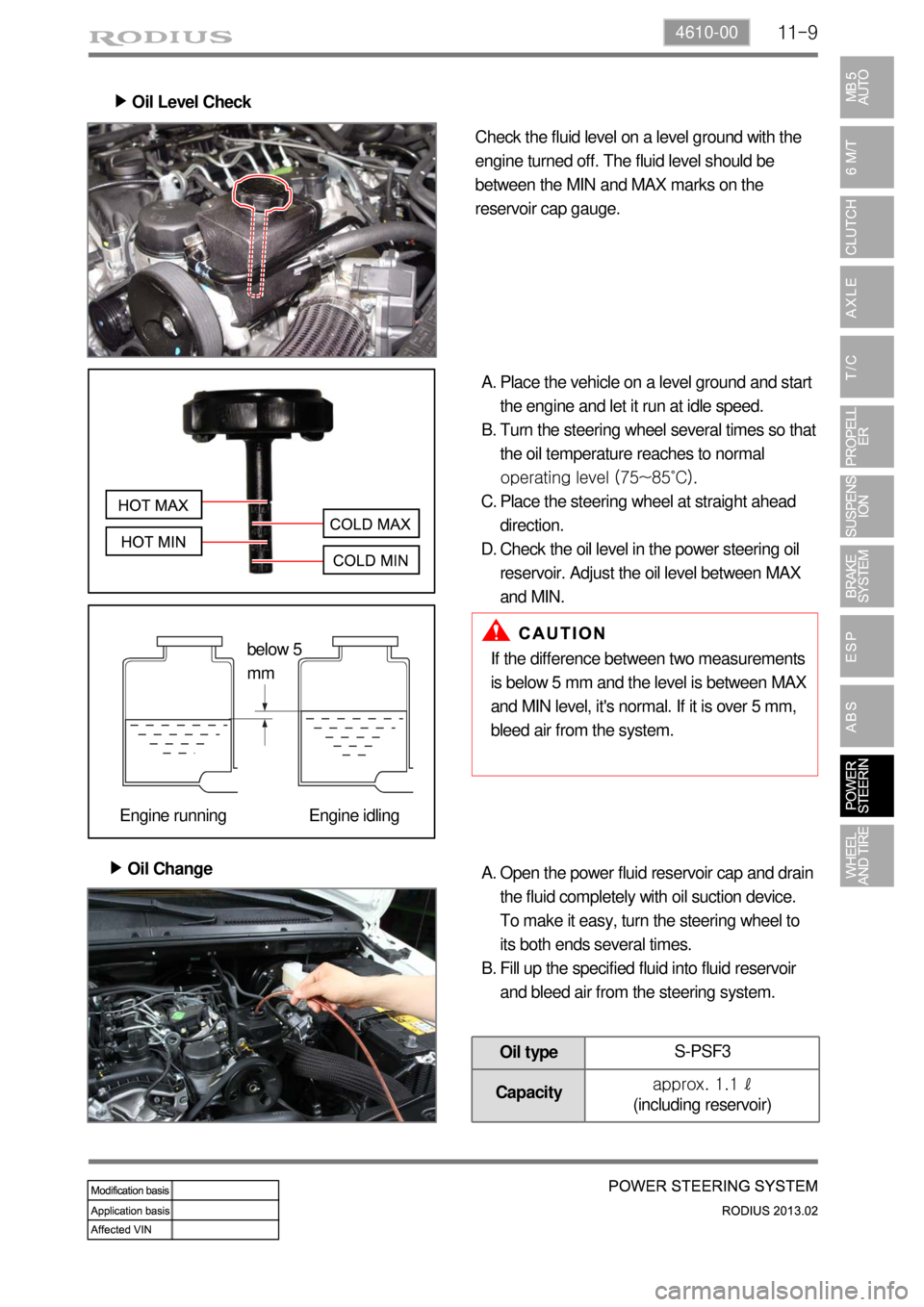Page 630 of 796
08-34850-03
Brake oil Grade DOT 4
Service interval Replace every 2 years
1. SPECIFICATIONS
Description Specification
Front brake Type Ventilated disc
Rear brake Type Ventilated disc
Master cylinder Type Step feed bore tandem, double cylinder
Brake booster Type Tandem type (integrated level sensor)
Operating type Foot operated type
Page 685 of 796
11-34610-00
1. SPECIFICATIONS
Description Specification
Steering wheelType 4-spoke type
Outer diameter (mm) 390
Steering gear boxType Rack and pinion type
Steering angleInner36.4°
Outer31.5°
Steering oil pumpType Vane type
Maximum pressure (kgf/cm2) 93.3 ~ 100.4
Pulley size (mm)Ø115
Operating temperature-40℃ ~ 150℃
Steering oilType S-PSF3
Capacity (L) approx. 1.1
Lower shaftType Universal joint
Angle(°) 38°
ConfigurationUniversal joint(top/bottom)
rubber coupling
Minimum turning radius (m) 6.09
Steering column shaft Tilting angle±2°
Steering wheel heating
indicatorPower consumption Below 95 W
Rated voltage13.5 ± 0.1 V
Usable voltage 9~16 V
Low voltage7.5 ± 0.5 V
High voltage18.0 ± 0.5 V
Rated voltage Max. 12.4 A
MemoryLast switch ON/OFF mode
memorized
Page 691 of 796

11-94610-00
Oil Level Check ▶
Check the fluid level on a level ground with the
engine turned off. The fluid level should be
between the MIN and MAX marks on the
reservoir cap gauge.
Place the vehicle on a level ground and start
the engine and let it run at idle speed.
Turn the steering wheel several times so that
the oil temperature reaches to normal
operating level (75~85˚C).
Place the steering wheel at straight ahead
direction.
Check the oil level in the power steering oil
reservoir. Adjust the oil level between MAX
and MIN. A.
B.
C.
D.
Oil Change ▶
If the difference between two measurements
is below 5 mm and the level is between MAX
and MIN level, it's normal. If it is over 5 mm,
bleed air from the system.
Open the power fluid reservoir cap and drain
the fluid completely with oil suction device.
To make it easy, turn the steering wheel to
its both ends several times.
Fill up the specified fluid into fluid reservoir
and bleed air from the steering system. A.
B.
Oil typeS-PSF3
Capacityapprox. 1.1 ℓ
(including reservoir)
below 5
mm
Engine running Engine idling
Page 695 of 796

11-134610-00
1. OVERVIEW
The power steering has been designed to make the wheel move more easily than in a manual steering
system. The hydraulic power assists the process utilizing hydraulic fluid. The fluid increases pressure
in the power steering pump and aids the movement of the steering mechanism. The power steering
system consists of pump, oil reservoir, rack and gear box. The power steering pump is a vane type
and delivers hydraulic pressure to operate the power steering system. The pressure relief valve in the
pump controls the discharging pressure. The rotary valve in the rack and the pinion gear directs the oil
from the power steering pump to one side of the rack piston. The integrated rack piston converts the
hydraulic pressure to linear movement. The operating force of the rack moves the wheels through the
tie rod, the tie rod end and the steering knuckle. Even though the hydraulic pressure cannot be
generated, a driver can steer the vehicle without power assist but it needs very high steering force. In
this case, the operating force of the steering wheel is conveyed to the pinion, and the movement of the
pinion moves the rack through the pinion gear combined to the rack gear.
Page 793 of 796
06-70000-00
Spoiler assembly
Spoiler design changed
Front
Front bumper fascia change results in installation design change
Rear
Changed from split type to integral type
Wheel house cover
Page:
< prev 1-8 9-16 17-24